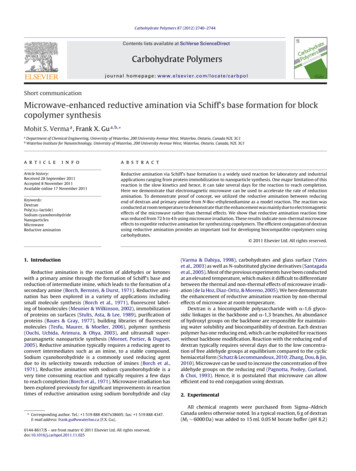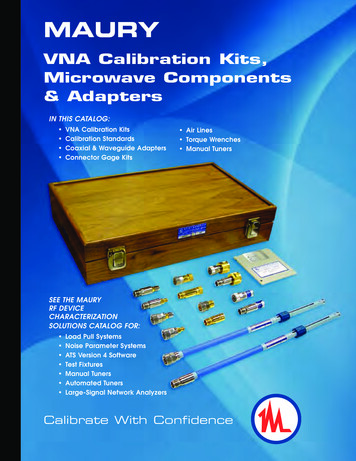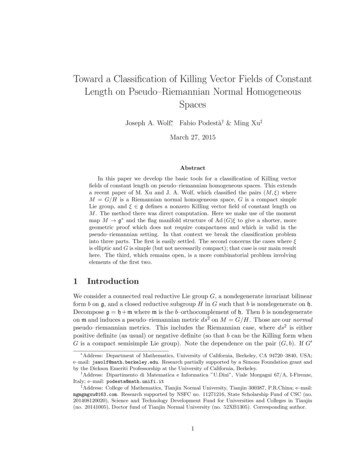
Transcription
Carbohydrate Polymers 87 (2012) 2740–2744Contents lists available at SciVerse ScienceDirectCarbohydrate Polymersjournal homepage: www.elsevier.com/locate/carbpolShort communicationMicrowave-enhanced reductive amination via Schiff’s base formation for blockcopolymer synthesisMohit S. Verma a , Frank X. Gu a,b, abDepartment of Chemical Engineering, University of Waterloo, 200 University Avenue West, Waterloo, Ontario, Canada N2L 3G1Waterloo Institute for Nanotechnology, University of Waterloo, 200 University Avenue West, Waterloo, Ontario, Canada, N2L 3G1a r t i c l ei n f oArticle history:Received 28 September 2011Accepted 8 November 2011Available online 17 November 2011Keywords:DextranPoly(d,l-lactide)Sodium cyanoborohydrideNanoparticlesMicrowaveReductive aminationa b s t r a c tReductive amination via Schiff’s base formation is a widely used reaction for laboratory and industrialapplications ranging from protein immobilization to nanoparticle synthesis. One major limitation of thisreaction is the slow kinetics and hence, it can take several days for the reaction to reach completion.Here we demonstrate that electromagnetic microwave can be used to accelerate the rate of reductionamination. To demonstrate proof of concept, we utilized the reductive amination between reducingend of dextran and primary amine from N-Boc-ethylenediamine as a model reaction. The reaction wasconducted at room temperature to demonstrate that the enhancement was mainly due to electromagneticeffects of the microwave rather than thermal effects. We show that reductive amination reaction timewas reduced from 72 h to 4 h using microwave irradiation. These results indicate non-thermal microwaveeffects to expedite reductive amination for synthesizing copolymers. The efficient conjugation of dextranusing reductive amination provides an important tool for developing biocompatible copolymers usingcarbohydrates. 2011 Elsevier Ltd. All rights reserved.1. IntroductionReductive amination is the reaction of aldehydes or ketoneswith a primary amine through the formation of Schiff’s base andreduction of intermediate imine, which leads to the formation of asecondary amine (Borch, Bernstei, & Durst, 1971). Reductive amination has been explored in a variety of applications includingsmall molecule synthesis (Borch et al., 1971), fluorescent labeling of biomolecules (Meunier & Wilkinson, 2002), immobilizationof proteins on surfaces (Stults, Asta, & Lee, 1989), purification ofproteins (Baues & Gray, 1977), building libraries of fluorescentmolecules (Tesfu, Maurer, & Moeller, 2006), polymer synthesis(Ouchi, Uchida, Arimura, & Ohya, 2003), and ultrasmall superparamagnetic nanoparticle synthesis (Mornet, Portier, & Duguet,2005). Reductive amination typically requires a reducing agent toconvert intermediates such as an imine, to a stable compound.Sodium cyanoborohydride is a commonly used reducing agentdue to its selectivity towards reduction of imines (Borch et al.,1971). Reductive amination with sodium cyanoborohydride is avery time consuming reaction and typically requires a few daysto reach completion (Borch et al., 1971). Microwave irradiation hasbeen explored previously for significant improvements in reactiontimes of reductive amination using sodium borohydride and clay Corresponding author. Tel.: 1 519 888 4567x38605; fax: 1 519 888 4347.E-mail address: frank.gu@uwaterloo.ca (F.X. Gu).0144-8617/ – see front matter 2011 Elsevier Ltd. All rights reserved.doi:10.1016/j.carbpol.2011.11.025(Varma & Dahiya, 1998), carbohydrates and glass surface (Yateset al., 2003) as well as N-substituted glycine derivatives (Santagadaet al., 2005). Most of the previous experiments have been conductedat an elevated temperature, which makes it difficult to differentiatebetween the thermal and non-thermal effects of microwave irradiation (de la Hoz, Diaz-Ortiz, & Moreno, 2005). We here demonstratethe enhancement of reductive amination reaction by non-thermaleffects of microwave at room temperature.Dextran is a biocompatible polysaccharide with -1,6 glycosidic linkages in the backbone and -1,3 branches. An abundanceof hydroxyl groups on the backbone are responsible for maintaining water solubility and biocompatibility of dextran. Each dextranpolymer has one reducing end, which can be exploited for reactionswithout backbone modification. Reaction with the reducing end ofdextran typically requires several days due to the low concentration of free aldehyde groups at equilibrium compared to the cyclichemiacetal form (Schatz & Lecommandoux, 2010; Zhang, Dou, & Jin,2010). Microwave can be used to increase the concentration of freealdehyde groups on the reducing end (Pagnotta, Pooley, Gurland,& Choi, 1993). Hence, it is postulated that microwave can allowefficient end to end conjugation using dextran.2. ExperimentalAll chemical reagents were purchased from Sigma–AldrichCanada unless otherwise noted. In a typical reaction, 6 g of dextran(Mr 6000 Da) was added to 15 mL 0.05 M borate buffer (pH 8.2)
M.S. Verma, F.X. Gu / Carbohydrate Polymers 87 (2012) 2740–27442741Scheme 1. Reaction scheme for the synthesis of dextran-b-PLA copolymer enhanced by microwave. A–C indicate protons which are identified in NMR spectra in Figs. 1 and2.along with 4 g of N-Boc-ethylenediamine (CNH Technologies, Massachusetts, USA) and 1 g sodium cyanoborohydride. The reductiveamination proceeded at room temperature in dark for either 4 hor 72 h. When a Discover Microwave System (CEM, Canada) wasused, the reaction temperature was set to 20 C and microwavepower was set to a maximum of 100 W. Reductive amination wasconducted in a sealed 35 mL cylindrical glass reaction vessel. Tomaintain the temperature of reagents at 20 C throughout the reaction, the reaction vessel was cooled down using pressurized air andmicrowave irradiation power was modulated by a feedback loopbuilt into the microwave system. 1 H NMR samples of dextran anddextran conjugated with N-Boc-ethylenediamine (dextran-Boc)were prepared in D2 O at 30 mg/mL after washing with methanol.NMR spectroscopy was conducted in a Bruker 300 MHz instrument.The Boc group from the dextran-Boc conjugate was deprotectedfor 1 h using 4 M hydrochloric acid. This was followed by deprotonation of the NH3 groups on the reducing terminus of dextranusing triethylamine to raise the pH to 9 for 1 h. After washingwith methanol, the amine terminated dextran (dextran-NH2 ) samples were assessed using 1 H NMR to confirm the absence of Bocpeak. Subsequently, the dextran-NH2 ( 3 g) was added to 40 mLDMSO in the presence of 5 g acid-terminated poly(d,l-lactide)(PLA, Mw 20 kDa Lakeshore Biomaterials, Alabama, USA) andconjugated with the aid of 120 mg N-(3-dimethylaminopropyl)-Nethylcarbodiimide (EDC) and 300 mg N-hydroxysulfosuccinimide(Sulfo-NHS, CNH Technologies, Massachusetts, USA) at room temperature for 4 h. The product was washed with methanol andthen purified using acetone to remove unreacted dextran. Uponaddition of acetone, a cloudy suspension was formed, which wascentrifuged at 4000 rpm for 10 min. The supernatant from thissuspension was extracted carefully and purged with air followed bydrying in vacuo. After purification, 1 H NMR samples were preparedas follows: pure dextran sample was prepared in D2 O at 30 mg/mL,pure PLA samples were prepared in CDCl3 at 5 mg/mL, whereas theblock copolymer of dextran and PLA (dextran-b-PLA) samples wereprepared in DMSO-d6 at 30 mg/mL.Nanoparticles were formed by dissolving dextran-b-PLA inDMSO at 10 mg/mL and adding 1 mL of the solution in a dropwise manner to 10 mL of Millipore filtered water under magneticstirring. The particle sizes were measured by 90Plus Particle SizeAnalyzer (Brookhaven, 659 nm at 90 ) at room temperature.The volume averaged multimode size distributions (MSD) werereported.3. Results and discussionReductive amination reaction was conducted between thereducing end of dextran and reactive amine terminal of N-Bocethylenediamine in the presence of a reducing agent sodiumcyanoborohydride. Reductive amination was carried out for either4 h or 72 h under ambient conditions. To characterize the effect ofmicrowave, reductive amination was carried out in a microwavesystem at room temperature for 4 h. The reductive amination ofdextran was characterized by 1 H Nuclear Magnetic Resonance(NMR) analysis. The 1 H NMR spectra showed that the proton on carbon 1 of dextran (Scheme 1) repeating units appeared at 4.86 ppm(Cheetham, Fialabeer, & Walker, 1990) (Fig. 1, peak A). The integration of peak A was compared to the integration of the Boc peak(Scheme 1) at 1.3 ppm (Geall, Taylor, Earll, Eaton, & Blagbrough,
2742M.S. Verma, F.X. Gu / Carbohydrate Polymers 87 (2012) 2740–2744Fig. 1. 1 H NMR spectra in D2 O for reductive amination reaction between dextran and N-Boc-ethylenediamine. Peak A resembles C1 proton peak on dextran repeating units andpeak B resembles Boc peak on N-Boc-ethylenediamine. Labels are I: pure dextran sample; II: pure N-Boc-ethylenediamine; III–V: dextran conjugated to N-Boc-ethylenediaminewith reaction conditions of non-microwave 4 h, non-microwave 72 h and microwave 4 h respectively. Peak assignments are outlined in Table 3.Fig. 2. 1 H NMR spectra for conjugated dextran-b-PLA. Peak C resembles CH proton peak on PLA repeating units. Labels are I: pure dextran sample in D2 O, II: pure PLA samplein CDCl3 ; III–V: dextran-b-PLA with initial reaction conditions of non-microwave 4 h, non-microwave 72 h and microwave 4 h respectively in DMSO-d6. Peak assignmentsare outlined in Table 3.
M.S. Verma, F.X. Gu / Carbohydrate Polymers 87 (2012) 2740–27442743Table 1Integrals from 1 H NMR of dextran conjugated to N-Boc-ethylenediamine.Peak labelPeak position (ppm)Relative integrals under the peaks for different reactionsNon-microwave 4 hBoc peak (peak B)Dextran C1 peak (peak A)[1.28 . . . 1.38][4.80 . . . 4.94]% Boc conjugated0.2431.00Non-microwave 72 h0.3841.0063%100%Microwave 4 h0.3261.0085%Table 2Integrals from 1 H NMR of dextran-b-PLA block copolymer.Peak labelPeak position (ppm)Relative integrals under the peaks for dextran-b-PLANon-microwave 4 hDextran C1 peak (peak A)PLA CH peak (peak C)[4.82 . . . 4.92][5.00 . . . 5.27]% PLA conjugated0.04681.005%2000) (Fig. 1, peak B) from N-Boc-ethylenediamine. Peak A (Fig. 1) isused as reference for the integrals in each spectrum and % Boc conjugated is determined by comparing each integral to the maximumintegral from peak B (Fig. 1) among the three reaction conditions.These results shown in Table 1 indicate that dextran-Boc synthesized using microwave has a significantly higher Boc conjugationefficiency compared to the non-microwave reaction for 4 h. Theconjugation efficiency of 4-h microwave reaction is also comparable to the 72-h non-microwave reaction. When in solution, glucoseresidues are known to undergo an equilibration process betweenclosed unreactive ring structures, which proceeds via the openchain reactive intermediate (Pagnotta et al., 1993; Yates et al.,2003), a process known as mutarotation (Pagnotta et al., 1993).It is postulated that the increased reaction rate from microwaveirradiation is due to increased rate of mutarotation of the reducingend glucose unit. This transition allows access to the reducing endof dextran molecule and since imine formation is the rate limitingstep (Borch et al., 1971) in reductive amination, the conjugationprocess is significantly enhanced.The dextran-Boc conjugate can be utilized to form an end to endblock copolymer with the biodegradable PLA. Such an amphiphilicblock copolymer can be used for self-assembly of nanoparticles.These nanoparticles have the potential of encapsulating hydrophobic drugs in the PLA core, while being biocompatible and watersoluble due to the dextran shell (Verma, Liu, Chen, Meerasa, & Gu,2011). Consequently, the dextran-Boc conjugate is deprotected.The resulting amine dextran-NH2 is conjugated to acid terminated PLA to form the linear block copolymer, dextran-b-PLA. Theblock copolymer is characterized using 1 H NMR in DMSO-d6 todetermine the relative amounts of PLA conjugated to dextran processed with and without microwave exposure. In the 1 H NMRspectra, the multiplet at 5.2 ppm belongs to the CH on the lactic acid (Scheme 1) repeating unit of PLA (Espartero, Rashkov, Li,Manolova, & Vert, 1996) (Fig. 2, peak C) and is compared to peakA from dextran repeating units. Using peak C as reference, integrals were calculated and normalized by the maximum integralNon-microwave 72 h0.3351.0039%Microwave 4 h0.8641.00100%values for the dextran peaks. This data is presented in Table 2 anddemonstrates that microwave irradiated dextran provides a 20-foldincrease in conjugation efficiency of PLA when compared to nonmicrowave irradiated dextran with the same reductive aminationreaction time of 4 h. The PLA conjugation efficiency of microwaveirradiated dextran-b-PLA was 2.5 times higher compared to 72 hreductive amination reaction sample. Thus, microwave providesan extremely useful route for polymer conjugation by reducing thereaction time by about 18-fold. Table 3 summarizes the peak assignments from Figs. 1 and 2 based on previous literature (Cheethamet al., 1990; Espartero et al., 1996; Geall et al., 2000; Zhang et al.,2010).Table 3Peak assignment for 1 H NMR spectra presented in Figs. 1 and 2.FigurePeak position (ppm)Peak assignmentFig. 1[1.28 . . . 1.38][2.55 . . . 2.65][2.95 . . . 3.10][3.10 . . . 4.00][4.80 . . . 4.94][1.30 . . . 1.55][5.00 . . . 5.27]CH3 Boc peakCH2 peak from –NH–CH2 –CH2 –NH2CH2 peak from –NH–CH2 –CH2 –NH2Glycosidic H from dextran (C2–C6)Anomeric H from dextran (C1)CH3 peak from PLACH peak from PLAFig. 2Fig. 3. Particle size distribution of nanoparticles formed by nanoprecipitation ofdextran-b-PLA copolymer using dextran from various reaction conditions. Graycolumns indicate non-microwave conditions for 4 h, red columns indicate nonmicrowave conditions for 72 h and blue columns indicate microwave exposure for4 h. (For interpretation of the references to color in this figure legend, the reader isreferred to the web version of the article.)
2744M.S. Verma, F.X. Gu / Carbohydrate Polymers 87 (2012) 2740–2744The amphiphilic block copolymer dextran-b-PLA was assessedfor self-assembly of nanoparticles by using nanoprecipitation. Theresulting nanoparticles were characterized using dynamic lightscattering. The nanoparticles obtained using microwave exposure or 72 h of reaction time were both comparable in size being29.3 2.0 nm and 29.0 2.0 nm respectively and were half thesize (60.3 11.4 nm) of that obtained from 4 h reaction withoutmicrowave exposure. The size distributions of these formulationsare shown in Fig. 3 and demonstrate that the 4 h reaction samplewithout microwave has a considerable population with bigger particle sizes which are absent in the other two reaction conditions. Itis postulated that the bigger particle size population around 90 nmis a result of nanoparticles formed from unmodified PLA since particle sizes of about 100 nm have been observed in literature for PLAnanoparticles (Musumeci et al., 2006). The nanoparticle size anddistribution exemplifies that microwave irradiation provides considerable savings in time of reaction while creating products withsame properties. Small particle size is important for the applicationof these nanoparticles in cancer drug delivery to allow accumulation by enhanced permeation and retention effect (Cho, Wang, Nie,Chen, & Shin, 2008; Verma et al., 2011).4. ConclusionIn this communication, we have highlighted a method thatutilizes the non-thermal effects of microwave irradiation forenhancing reductive amination reaction in polymer conjugation.This method has allowed us to synthesize the desired nanoparticles in a fraction of the time. This advancement provides promisingopportunities for the scale-up and combinatorial synthesis of products involving reductive amination reactions.AcknowledgementThis work was financially supported by Natural Sciences andResearch Council of Canada.ReferencesBaues, R. J., & Gray, G. R. (1977). Lectin purification on affinity columns containingreductively aminated disaccharides. Journal of Biological Chemistry, 252, 57–60.Borch, R. F., Bernstei, M. D., & Durst, H. D. (1971). Cyanohydridoborate anionas a selective reducing agent. Journal of the American Chemical Society, 93,2897–2904.Cheetham, N. W. H., Fialabeer, E., & Walker, G. J. (1990). Dextran structural detailsfrom high-field proton NMR-spectroscopy. Carbohydrate Polymers, 14, 149–158.Cho, K. J., Wang, X., Nie, S. M., Chen, Z., & Shin, D. M. (2008). Therapeutic nanoparticlesfor drug delivery in cancer. Clinical Cancer Research, 14, 1310–1316.de la Hoz, A., Diaz-Ortiz, A., & Moreno, A. (2005). Microwaves in organic synthesis. Thermal and non-thermal microwave effects. Chemical Society Reviews, 34,164–178.Espartero, J. L., Rashkov, I., Li, S. M., Manolova, N., & Vert, M. (1996). NMR analysisof low molecular weight poly(lactic acid)s. Macromolecules, 29, 3535–3539.Geall, A. J., Taylor, R. J., Earll, M. E., Eaton, M. A. W., & Blagbrough, I. S. (2000). Synthesisof cholesteryl polyamine carbamates: pK(a) studies and condensation of calfthymus DNA. Bioconjugate Chemistry, 11, 314–326.Meunier, F., & Wilkinson, K. J. (2002). Nonperturbing fluorescent labeling of polysaccharides. Biomacromolecules, 3, 857–864.Mornet, S., Portier, J., & Duguet, E. (2005). A method for synthesis and functionalization of ultrasmall superparamagnetic covalent carriers based on maghemiteand dextran. Journal of Magnetism and Magnetic Materials, 293, 127–134.Musumeci, T., Ventura, C. A., Giannone, I., Ruozi, B., Montenegro, L., Pignatello, R.,et al. (2006). PLA/PLGA nanoparticles for sustained release of docetaxel. International Journal of Pharmaceutics, 325, 172–179.Ouchi, T., Uchida, T., Arimura, H., & Ohya, Y. (2003). Synthesis of poly(l-lactide)end-capped with lactose residue. Biomacromolecules, 4, 477–480.Pagnotta, M., Pooley, C. L. F., Gurland, B., & Choi, M. (1993). Microwave activationof the mutarotation of alpha-d-glucose—An example of an intrinsic microwaveeffect. Journal of Physical Organic Chemistry, 6, 407–411.Santagada, V., Frecentese, F., Perissutti, E., Fiorino, F., Severino, B., Cirillo, D., et al.(2005). Efficient microwave combinatorial parallel and nonparallel synthesis ofN-alkylated glycine methyl esters as peptide building blocks. Journal of Combinatorial Chemistry, 7, 618–621.Schatz, C., & Lecommandoux, S. (2010). Polysaccharide-containing block copolymers: Synthesis, properties and applications of an emerging family ofglycoconjugates. Macromolecular Rapid Communications, 31, 1664–1684.Stults, N. L., Asta, L. M., & Lee, Y. C. (1989). Immobilization of proteins on oxidizedcrosslinked sepharose preparations by reductive amination. Analytical Biochemistry, 180, 114–119.Tesfu, E., Maurer, K., & Moeller, K. D. (2006). Building addressable libraries: Spatially isolated, chip-based reductive amination reactions. Journal of the AmericanChemical Society, 128, 70–71.Varma, R. S., & Dahiya, R. (1998). Sodium borohydride on wet clay: Solvent-freereductive amination of carbonyl compounds using microwaves. Tetrahedron, 54,6293–6298.Verma, M. S., Liu, S., Chen, Y. Y., Meerasa, A., & Gu, F. X. (2011). Size-tunable nanoparticles composed of dextran-b-poly(d,l-lactide) for drug delivery applications.Nano Research, doi:10.1007/s12274-011-0184-zYates, E. A., Jones, M. O., Clarke, C. E., Powell, A. K., Johnson, S. R., Porch, A., et al.(2003). Microwave enhanced reaction of carbohydrates with amino-derivatisedlabels and glass surfaces. Journal of Materials Chemistry, 13, 2061–2063.Zhang, Y. L., Dou, X. W., & Jin, T. (2010). Synthesis and self-assembly behavior of amphiphilic diblock copolymer ) in aqueous media. Express Polymer Letters, 4, 599–610.
Reductive amination via Schiff's base formation is a widely used reaction for laboratory and industrial applications ranging from protein immobilization to nanoparticle synthesis. One major limitation of this reaction is the slow kinetics and hence, it can take several days for the reaction to reach completion.










